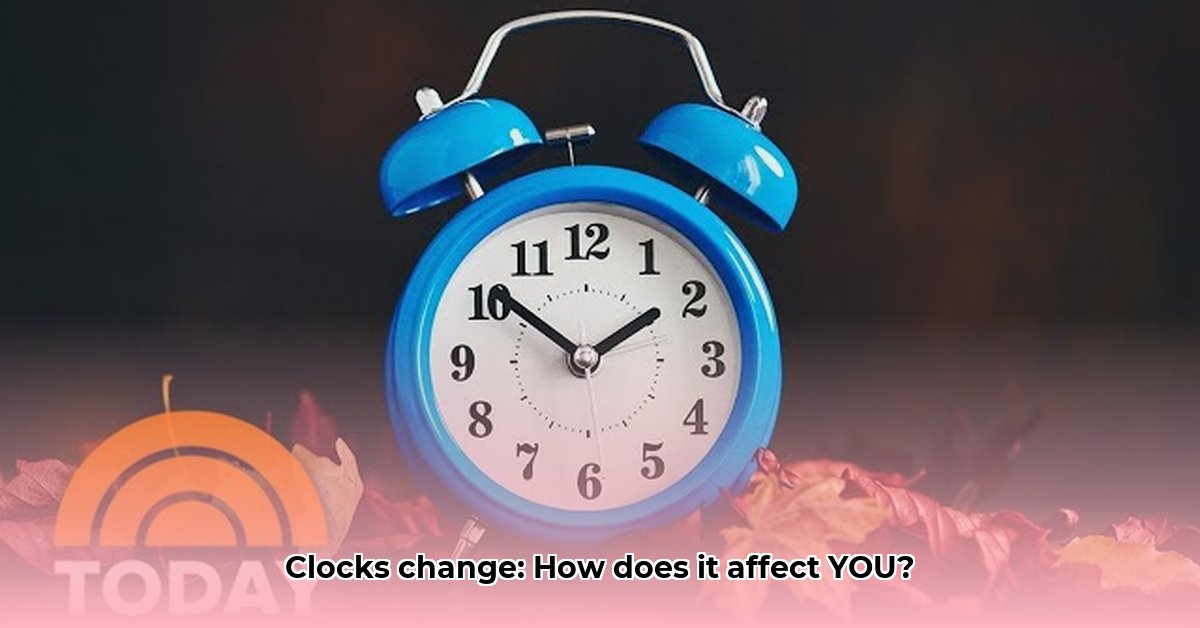Did you remember to set your clocks back? This weekend’s time change marks the end of Daylight Saving Time (DST), and while it might seem like a simple adjustment, the annual shift actually sparks a big debate. It’s not just about moving the hands on your watch; it’s about the real impact on our health, our work, and even our politics. We’ll explore how DST affects everything from our sleep and mood to our productivity at work and the energy we use. We’ll also look at why making DST permanent – or even getting rid of it altogether – has proven so difficult. Get ready to dive into the surprisingly complex world of time itself!
The End of Daylight Saving Time: Navigating the Debate and Health Impacts
As clocks fall back, marking the end of Daylight Saving Time (DST), many simply adjust their clocks and continue their routines. However, this annual event ignites a complex debate regarding its multifaceted impacts. This article delves into the history, controversies, and current state of DST, examining arguments for and against it, and exploring the uncertain future of this long-standing practice. The focus extends beyond a mere discussion of timekeeping to analyze DST’s influence on health, economics, and policy.
A Brief History of DST: From Wartime Measures to Modern Debate
Daylight Saving Time’s US history started during World War I in 1918, with the Standard Time Act, aimed at conserving energy and maximizing daylight during wartime. While inconsistent observation occurred, the Uniform Time Act of 1966 standardized DST across most states. Hawaii and Arizona opted out, reflecting differing perspectives on its merits. This historical perspective provides a foundation for understanding ongoing discussions surrounding DST’s overall value.
The Great DST Debate: Weighing the Pros and Cons
The decision to maintain or eliminate DST remains contentious. Proponents cite potential benefits like energy savings and increased opportunities for leisure activities due to extended daylight hours. However, critics argue that the downsides outweigh the advantages, citing detrimental effects on health, productivity, and business.
Here’s a breakdown of arguments:
| Argument For DST | Argument Against DST |
|---|---|
| Potential for small energy savings. | Significant disruptions to sleep schedules, negatively impacting health and productivity. |
| Possible reduction in crime rates. | Increased risk of accidents, particularly in transportation. |
| Extended daylight hours for recreation and outdoor activities, boosting retail. | Negative impacts on circadian rhythms, potentially leading to health issues. |
| Potential economic benefits in some sectors. | Disruptions to business schedules, supply chains, and workforce efficiency. |
| Allows for better alignment with the schedules of countries that observe DST. | Can exacerbate Seasonal Affective Disorder (SAD) due to reduced morning sunlight. |
| Can increase opportunities for outdoor exercise and recreation, promoting physical health. | Requires adjustments to agricultural practices, potentially impacting crop yields. |
| May reduce evening traffic congestion due to longer daylight hours. | Can create confusion and errors in scheduling and time-sensitive industries, such as healthcare and finance. |
| Can improve consumer confidence and spending due to longer perceived daylight hours. | The need to reset clocks twice a year is an inconvenience and can lead to missed appointments. |
Health Impacts: Beyond Feeling Sleepy
Health consequences from DST are significant and frequently cited against its continuation. The hour shift disturbs our sleep-wake cycle. This disruption of the circadian rhythm leads to sleep deprivation, fatigue, mood swings, and health problems. Studies link DST to increased risk of heart attacks, strokes, and hospital admissions. A 2020 study in Current Biology found that DST was associated with a 6% increase in fatal car accidents in the week following the switch. These findings raise questions about DST’s purported advantages versus potential health risks. Dr. Karin Johnson, a neurology professor at UMass Chan Medical School-Baystate, emphasizes the importance of aligning with solar time for optimal health.
Economic Considerations: Beyond Energy Savings
While some argue DST boosts economic activity via extended daylight hours, economic consequences are unclear. Sectors may benefit, others face challenges. The transportation industry sees increased accidents, linked to driver fatigue. These accidents impact supply chains, causing delays and losses. The Journal of Applied Psychology published research indicating a temporary dip in worker productivity post-DST. The overall economic impact from DST requires examination.
The Political Landscape: A Stalled Act and the Search for a Solution
The Sunshine Protection Act, to make DST permanent, passed the Senate in 2022 but is stalled in the House. This stalemate reveals divisions. Farmers, whose work relies on natural daylight, oppose permanent DST, highlighting the difficulty in implementing a nationwide solution. The act, sponsored by Senator Marco Rubio (R-FL), reflects a growing awareness of the issue’s complexity.
A Nation Divided by Time: Looking Ahead in 2025
As clocks go back, the DST debate continues. The lack of an easy solution reveals the intricate relationship between social needs, economic concerns, and public health. Perhaps it’s time to explore holistic approaches to improve alignment with circadian rhythms. Research from the American Academy of Sleep Medicine suggests that permanent standard time aligns better with human biology. The discussion continues, and DST implementation remains uncertain, pending research and compromise.
Optimizing Sleep Schedules: Mitigating the Risks of Permanent Daylight Saving Time
Key Takeaways:
- Daylight Saving Time (DST) disrupts natural sleep cycles, leading to health problems.
- The spring forward transition is particularly disruptive.
- Steps to mitigate negative health effects involve proactive measures and public health initiatives.
Brief History and DST Mechanics
Daylight Saving Time’s origins began during World War I, conserving energy. The Uniform Time Act of 1966 standardized DST within the U.S., yet implementation remains debated. DST shifts the clock forward an hour in spring, backward in fall. This triggers schedule adjustments and a ripple effect of disruptions.
The Great DST Debate: Arguments For and Against
DST’s proponents highlight evening activities, benefiting retail, tourism, and recreation. Energy savings are debated. Critics point to disruptions to body clocks, leading to sleep deprivation and reduced productivity. The spring-forward shift is most problematic, leaving people feeling “jet lagged.”
The Price of Time: Health Impacts of DST
Studies link DST to increased car accidents, cardiovascular incidents, and mood disorders. Sleep deprivation, from circadian rhythm disruption, weakens the immune system and impacts cognitive function. Teenagers and those with sleep problems are vulnerable.
Economic Clock: Productivity and Industries
Some argue DST boosts retail and outdoor activities, others point to costs associated with reduced productivity and increased healthcare expenses. The economic impact is complex and depends on the sector.
Policy and Politics: The Time War
The Sunshine Protection Act aims at making DST permanent but is stalled due to concerns. The debate highlights a need for a balanced approach to timekeeping, weighing economic benefits against potential health risks. Public health officials’ recommendations are essential.
How to Mitigate Negative Health Effects of Permanent Daylight Saving Time: Practical Steps
Whether DST remains seasonal or becomes permanent, you can take steps to lessen the impact:
- Gradual Adjustment: Days before the transition, adjust your sleep schedule 15-20 minutes earlier each day.
- Consistent Sleep Hygiene: Maintain a regular sleep schedule, even on weekends.
- Optimize Sleep Environment: Create a dark, quiet, and cool bedroom.
- Reduce Screen Time: Limit exposure to electronic devices before bed. Blue light emitted from screens interferes with melatonin production.
- Mindful Caffeine/Alcohol Intake: Avoid these substances close to bedtime. Caffeine is a stimulant, and alcohol disrupts sleep cycles.
- Morning Sunlight Exposure: Expose yourself to natural sunlight in the morning to help regulate your circadian rhythm.
- Regular Exercise: Engage in regular physical activity, but avoid intense workouts close to bedtime.
- Healthy Diet: Maintain a balanced diet to support overall health and sleep quality.
- Stress Management: Practice stress-reduction techniques like meditation or yoga.
- Consult Healthcare Professionals: If you experience persistent sleep problems, consult a doctor.
The Impact of Daylight Saving Time on Agricultural Practices in the US
Key Takeaways:
- Disrupted Routines: Daylight Saving Time and its Effects on Agricultural Practices in the US significantly disrupt carefully planned schedules of American farms, impacting livestock feeding and fieldwork.
- Animal Welfare Concerns: Changes in light cycles negatively affect animal health and productivity, leading to reduced milk yields and increased stress in livestock.
- Reduced Productivity: Farmers face scheduling conflicts and increased workload, potentially leading to reduced crop yields and overall farm output.
Brief History and the Mechanics of DST
Daylight Saving Time (DST) isn’t a new idea. It was first implemented in the US during World War I to conserve energy. The Uniform Time Act of 1966 standardized the practice, though debates continue. The current system involves “springing forward” an hour in the spring and “falling back” an hour in the fall. The process involves adjusting clocks, impacting schedules, and triggering a cascade of consequences, especially in sectors heavily reliant on natural cycles and consistent routines like agriculture.
DST and Animal Welfare: A Critical Intersection
Dairy farmers are particularly sensitive to DST. Cows are creatures of habit,
- Uncover the Verna Garver Timeline: A Life Beyond Hollywood - July 20, 2025
- Uncover Verna Garver’s Untold Story: A Life Beyond Headlines - July 20, 2025
- UPCI Missions Japan History: Lucas Family’s 30-Year Impact - July 20, 2025
















